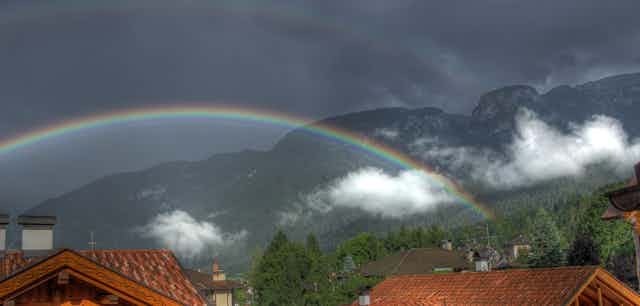This is an article from Curious Kids, a series for children. The Conversation is asking kids to send in questions they’d like an expert to answer. All questions are welcome – serious, weird or wacky!
Why are rainbows round? – Georgina, age 5.
This is a really complicated question. It’s a hard thing even for many adults to understand. To answer your question, I have to explain two things – refraction and reflection.
Refraction gives you the colours of the rainbow, and reflection gives you its round shape.
Refraction and colour
When you are out on a bright sunny day, it may look like sunlight is all one colour. But in fact, the white sunlight you see is made up of many different colours of light mixed together.
But what are different colours of light? In fact, light is a wave. Light waves come in different sizes called “wavelengths”. Every colour has a different wavelength. For example, violet light has a much shorter wavelength than red light.

The next thing to know is that when light enters water at an angle, it changes direction. This is called “refraction”. You can see this every time you look into a pond. Ripples on the water make everything under the water look wonky. This is because the light bends as it goes between the air and the water. The amount the light bends depends on its colour.

The shorter the wavelength of the colour, the more it changes direction. So violet light changes direction more than green light. And yellow light changes direction more than red light.
Refraction is why all the colours in the sunlight end up separating when it hits the water drop, and we are then able to see all the colours of the rainbow.
Reflection and shape
Now we can move onto why rainbows have a round shape. The final thing that happens when sunlight hits a raindrop is that some of that light bounces back, or is “reflected”.
So when you see a rainbow, you’re actually seeing light that has hit a raindrop and bounced back onto your eye.
Here’s where we need to get stuck into some maths. In raindrops, sunlight bounces back, or reflects, most strongly at a certain angle - 42 degrees.

If we draw rays of sunlight that reflect at 42 degrees into your eyes then those rays start to look like they form a circular arc in the sky. So the reflection gives you the shape of the rainbow, while the refraction gives you the colours of the rainbow.
If you are standing on the ground, then the rainbow stops when it hits the ground. If you are lucky enough to look out on some rain from a plane, then instead of seeing just a part of the circle, you may be able to see a complete circular rainbow, like this:

If you like rainbows – and who doesn’t – then there is a whole website full of them here. This site shows many examples of different types of rainbows and other natural light shows that happen as sunlight is refracted and reflected by the Earth’s atmosphere.
Hello, curious kids! Have you got a question you’d like an expert to answer? Ask an adult to send your question to us. They can:
* Email your question to curiouskids@theconversation.edu.au
* Tell us on Twitter by tagging @ConversationEDU with the hashtag #curiouskids, or
* Tell us on Facebook

Please tell us your name, age, and which city you live in. You can send an audio recording of your question too, if you want. Send as many questions as you like! We won’t be able to answer every question but we will do our best.

